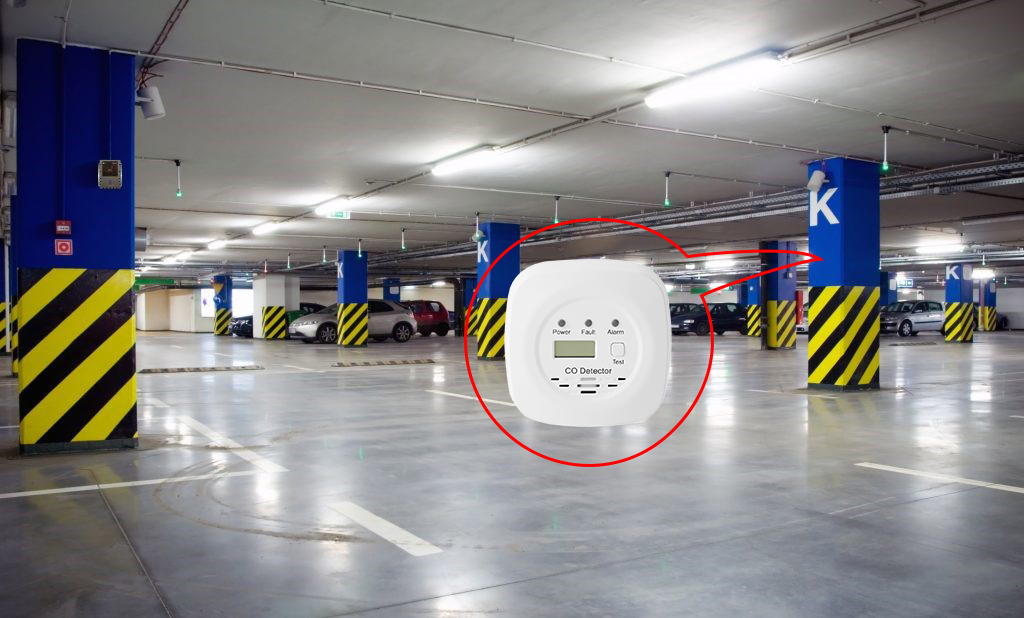On every floor, including the basement.
You should install CO alarms at least 5 feet over the floor, as CO is lighter than air and rises. You can also install the CO alarm on a ceiling if you prefer.
1. Install the carbon monoxide detector on a wall or high up near the ceiling. And when installing a battery-operated detector, you should install it on the wall below the ceiling, not on the ceiling. Many battery-operated detectors prefer wall mounting, so be sure to check the manufacturer's instructions.
2. Before installing a carbon monoxide detector, you need to decide the installation location by testing the warning alarm of the detector, make sure that the alarm can be heard in other places.
3. Do not install the carbon monoxide detector within 5m of any heating or cooking equipment such as a stove or dryer. If doing so, it may cause false alarms.
4. Do not install carbon monoxide detectors where windows are often opened.
Underground Parking Garage Installation Requirements
1. The carbon monoxide detector installed in the underground parking garage should be installed 1.5m above the ground, and should adopt the wall-mounted method, installed in the air circulation position.
2. It is recommended to divide the zone according to fire prevention, area size, etc. Normally, every 200-300m should install a carbon monoxide detector.
3. The carbon monoxide detector should be installed in a place without shock, vibration, and strong electromagnetic field interference, and there should be no less than 0.3m of clean air around.
4. The installation and wiring of the carbon monoxide detector should be carried out in accordance with the requirements of the manufacturer, and should comply with the relevant regulations on the installation and wiring of explosion-proof instruments.
According to the "Green Building Evaluation Standard", the underground parking garage needs to be equipped with a carbon monoxide concentration monitoring device linked to the exhaust system. It is for:
1. It is a consideration of safety, ensuring the carbon monoxide concentration in the garage is at a normal value.
2. Automatically judge whether to activate the exhaust function according to the concentration of carbon monoxide in the underground parking garage, saving energy and avoiding unnecessary waste.
3. According to the toxicity of carbon monoxide, we know that 50ppm is the maximum limit that an adult can bear within eight hours. It is recommended that the alarm value of carbon monoxide detectors be set at 30ppm. When the concentration value exceeds 30ppm, the detector will automatically alarm and activate the exhaust system.

How to Install Carbon Monoxide Detector
1. Read the manufacturer’s installation manual carefully.
2. Choose a drill bit that’s a little bit smaller than the wall anchors.
3. Mark the screw holes of the mounting base.
4. Tap the screw anchors into the wall with a hammer.
5. Put the screws in the wall.
6. Line up the mounting base with the screws.
7. According to the CO detector’s user manual, connect the wires or install the batteries (Follow the CO type)
8. Screw the CO detector into the screws.
9. Tighten the screws with a screwdriver.
10. Mount the alarm onto its base.
Maintain Carbon Monoxide Detector
After installing the carbon monoxide detector, you should do some maintenance keep it normal.
1. Test the carbon monoxide detector at least once a month. Most of them just need to press a button to test the alarm and the battery.
2. Replace the battery every 6 months even if you don’t hear the warning beep. If you are using a lithium-ion battery, replace the battery every 10 years.
3. Vacuum every detector once a year to clean the dust or particles in it.
4. Check the date of manufacture of each device regularly and replace them when expired


 What is Fire Hose?
What is Fire Hose?
 What is Water-proof Fire Alarm System?
What is Water-proof Fire Alarm System?
 Addressable Explosion-proof Fire Alarm System Introduction
Addressable Explosion-proof Fire Alarm System Introduction
 Emergency Lighting System Installation Guide
Emergency Lighting System Installation Guide